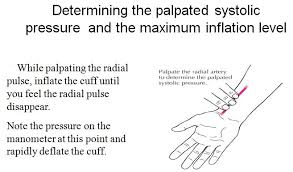How To Measure Blood Pressure (BP) Using Mercury Sphygmomanometer And Stethoscope
There are devices used to measure blood pressure. But they all depend on a single principle. The gold standard is the manual Mercury column sphygmomanometer and stethoscope.
A sphygmomanometer is a device that measures blood pressure. It consists of an inflatable rubber cuff which is wrapped around the arm. The inflation is achieve with a bulb that is regulated by a valve. The Mercury is in a calibrated column that indicates the cuff pressure.
A stethoscope is used to listen to the sound. It consists of a diaphragm with 2 flat circular parts where the wider side contains a thin plastic and an earpiece connected with a tube to the diaphragm.
 |
| Mercury sphygmomanometer |
 |
| Android sphygmomanometer and stethoscope |
Another sphygmomanometer is the aneroid. It is the same with the Mercury column sphygmomanometer in terms of working principle. The only difference is that the Mercury column is replaced with a metal bellows-watch like movement.
This bellows-watch is connected to the compression cuff.
The digital blood pressure measurement machine is used to check blood pressure but needs confirmation from the manual device for diagnosis. There are other new types that either have passed the accepted level or yet to. You can check previous posts on how to use digital blood pressure measuring devices in this blog.
Read Also: How to use digital sphygmomanometer
Precautions When Using Sphygmomanometer
For blood pressure measurement to be accurate, there are many things that must be done or avoided. Both the person performing the test and the person being tested should know what is required. There are different causes of blood pressure fluctuations.
This will determine when it is proper to take measurement. Some people have nocturnal high blood pressure while others have an increased blood pressure during the day. Some use hourly blood pressure result to diagnose a patient instead of relying on some few reading. They argue that those with nortunal hypertension may not be hypertensive during the day which may make diagnose wrong.
1. However, the standard time recommended is first thing in the morning before eating or drinking
2. A 5 minutes rest is recommended when it is done during the day
3. Some foods alter the result of blood pressure measurement hence should be avoided 30 minute before measurement e.g caffeine
4. Empty bladder before the test
5. The test should be done more than once and the average taken. This helps to avoid white-coat syndrome (fear of hospitals or clinics or even the person doing the test which subsides after the first test)
6. Test both arms and use that arm with the high systolic value for subsequent test. When the difference between both arm measurement is more than 10mmHg, it is caused by coarctation of the aorta. If not , use the left arm as it is closer to the heart. When two or more tests are done, separate tests with 3 minutes.
7. The size of the cuff should cover at least 75-100 % of the circumference of the arm for the results to be accurate. Too small cuffs will give high value and too big cuffs will give low results. Cuff width should be about 35-50% of the circumference of the arm. That is length: width ratio of 1:2 of the circumference of the arm
8. No clothing should cover the arm and don't fold sleeve up the arm as that can add extra pressure to the arm
9. Both the person taking the measurement and the person that is checking the blood pressure must not talk or move about
10. The Mercury column should be about 3 feet away and at eye level when taking reading.
Principle Of Sphygmomanometer
Working of sphygmomanometer

The bulb is connected to the cuff and the cuff is connected to the Mercury column with a rubber tubing. During inflation of the cuff by pressing multiple times on the bulb, air pressure enters the cuff.
This same air pressure travels through the cuff into the Mercury column that forces the Mercury up the calibrate column according to the pressure received. But when the Mercury column is replaced with a metal bellows-watch, the pressure rotates a gear that turns a printer pivoted in bearings along a calibrated dial.
The artery that brings blood from the heart to the hand is called branchial. It is just at the upper part of the elbow and branch into two there. During inflation of the cuff, the cuff adds pressure to the artery. The pressure on the artery begins to reduce the volume of blood that flows through the artery. The pressure that prevents blood flow completely through the artery is called the systolic blood pressure.
When deflating the cuff, blood starts flowing again. The first blood that flows through usually does that at a very high pressure which results in a sound that can be picked up by a stethoscope. There comes a time when the pressure is so small that blood flows easily without turbulence and is streamline. This present without any more sound. The last sound heard is diastolic pressure level. Without the cuff pressure, a stethoscope cannot pick up the sound of the brachial artery. The sound is as a result of the pressure of blood that flows past it.
 |
| Blood pressure measurement |
Procedure Of Blood Pressure Measurement
1. Make the person sit in a chair. The back of the person must be straight.
2. The feet should be flat on the floor.
3. The arm should be at the same level with the heart with palm facing up
4. Place the sphygmomanometer beside the arm to be use on the table
5. Open the sphygmomanometer and open the knob of the Mercury column
6. Take the cuff and wrap it around the arm. The arrow on the cuff should be at the branchial artery just above the elbow. The cuff should be 2-3 cm above the elbow. It should be tight but a finger or two can enter. Read Also: Blood pressure measurement of digital sphygmomanometer are accurate
Palpitation
Palpation technique

1. Place the pulp of to left four fingers on the outer aspect of the wrist of the arm to be measured. Feel the radial pulse beat
2. Close the valve of the bulb and start to pump
3. Stop the pumping when the pulse beat stops or disappears and take the reading. That is palpated systolic level and maximum inflation level.
Auscultation
1. Remove your hands from the radial pulse
2. Inflate the cuff 30mmHg above the palpated systolic level. Some inflate up to 180-200 mmHg
3. Place the stethoscope diaphragm (flat, round surface) on the cubital fossa/ventral aspects of the elbow. That is below the cuff.
4. Put the stethoscope in your ear according to the ear design
5. Begin to deflate at not more than 3mmHg/second
The first thumping sound is the systolic blood pressure which is called the korotkoff sound. The sound is picked up by the stethoscope.
Sounds of different intensity continue to beat as the cuff keeps deflating until the last sound.
The tube from the bulb and that going to the Mercury column is designed to lie over the brachial artery. When the turbulent blood starts flowing past, it vibrates the tube which in turn sends the vibration to the Mercury column. It is pick up in the mercury as vibration.
Note: other parts of the body can be use to measure blood pressure using the same principle. The readings are usually different from that of the arm.

Comments
Post a Comment
Please have your say